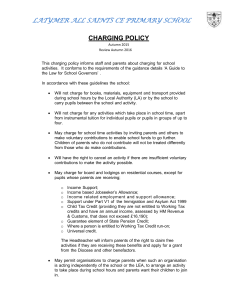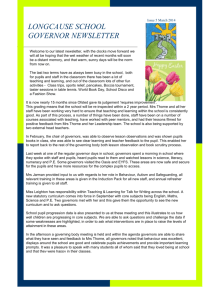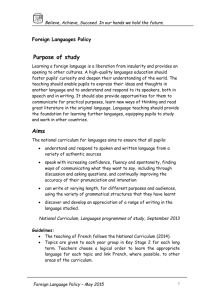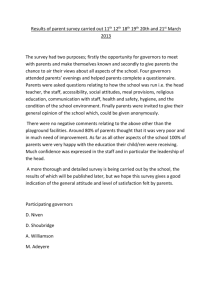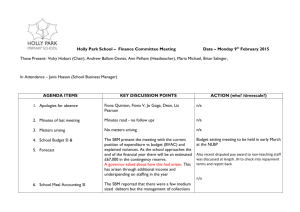Introduction to School Finance
advertisement
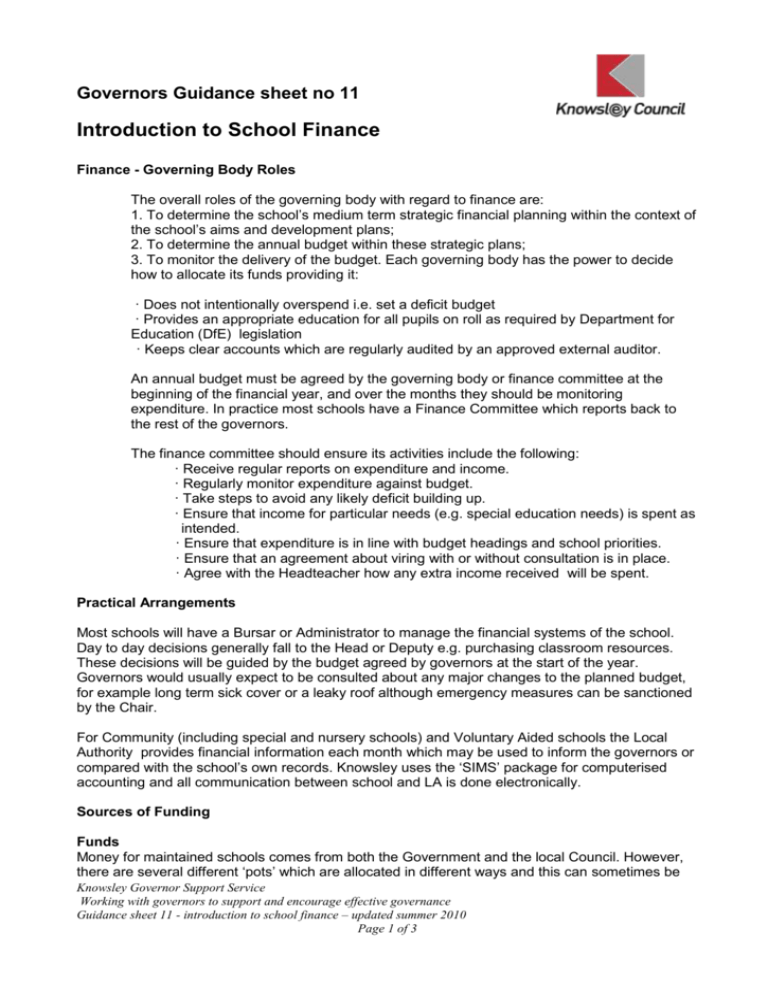
Governors Guidance sheet no 11 Introduction to School Finance Finance - Governing Body Roles The overall roles of the governing body with regard to finance are: 1. To determine the school’s medium term strategic financial planning within the context of the school’s aims and development plans; 2. To determine the annual budget within these strategic plans; 3. To monitor the delivery of the budget. Each governing body has the power to decide how to allocate its funds providing it: · Does not intentionally overspend i.e. set a deficit budget · Provides an appropriate education for all pupils on roll as required by Department for Education (DfE) legislation · Keeps clear accounts which are regularly audited by an approved external auditor. An annual budget must be agreed by the governing body or finance committee at the beginning of the financial year, and over the months they should be monitoring expenditure. In practice most schools have a Finance Committee which reports back to the rest of the governors. The finance committee should ensure its activities include the following: · Receive regular reports on expenditure and income. · Regularly monitor expenditure against budget. · Take steps to avoid any likely deficit building up. · Ensure that income for particular needs (e.g. special education needs) is spent as intended. · Ensure that expenditure is in line with budget headings and school priorities. · Ensure that an agreement about viring with or without consultation is in place. · Agree with the Headteacher how any extra income received will be spent. Practical Arrangements Most schools will have a Bursar or Administrator to manage the financial systems of the school. Day to day decisions generally fall to the Head or Deputy e.g. purchasing classroom resources. These decisions will be guided by the budget agreed by governors at the start of the year. Governors would usually expect to be consulted about any major changes to the planned budget, for example long term sick cover or a leaky roof although emergency measures can be sanctioned by the Chair. For Community (including special and nursery schools) and Voluntary Aided schools the Local Authority provides financial information each month which may be used to inform the governors or compared with the school’s own records. Knowsley uses the ‘SIMS’ package for computerised accounting and all communication between school and LA is done electronically. Sources of Funding Funds Money for maintained schools comes from both the Government and the local Council. However, there are several different ‘pots’ which are allocated in different ways and this can sometimes be Knowsley Governor Support Service Working with governors to support and encourage effective governance Guidance sheet 11 - introduction to school finance – updated summer 2010 Page 1 of 3 quite confusing for governors to plan and monitor. Individual School Budget (ISB) This is the largest allocation of funds to most schools and depends on a number of factors. Each Local Authority (LA) receives a grant from Central Government and adds some of the revenue from Council Tax to fund all of its education services. No two LA’s will have the same amount to spend. Having deducted a small proportion for centrally provided services, the remainder is divided among the schools in the Authority. This is called the Individual Schools Budget (ISB). How much each school will get depends on a complicated formula which will be different in each Authority. However, it will always include an amount per pupil, often weighted by their age e.g. pupils in exam years will attract a higher sum because of the level of administration required. Additional amounts may be allocated to schools with a high proportion of children qualifying for free school meals, split sites or other costly elements. The total number of pupils is taken from the Spring school census. School funding is, therefore primarily driven by the pupil numbers in the January of the preceding financial year. Increases or decreases in roll during the year will attract funding if the change is significant. At least 75% of the funding must be distributed on the basis of the number in children in the school. School Standards Fund This is money from the Department for Education (DfE) to be used for specific purposes. Standards money is available to schools through their LA for improvement projects, including staff and governor training. The focus for these improvement projects is determined by the DfE each year but the money is not ‘ring-fenced’ for these projects alone. There is also a limit on the time allowed to spend the grant; it must be spent by the end of August in the financial year after that in which it is approved. The grant will be reclaimed if it has not been spent in time. Extra grants from Government From time to time the Government may wish to invest in a particular aspect of the curriculum or school improvement and offer supplementary or top-up funds to schools. Again these grants are usually to be spent on a specific target, for example £2,000 per school for reading books. There may also be a time limit on these sums and it can be quite difficult to plan for them. Special Needs Funding ASEN funding is distributed to mainstream primary and secondary schools on a formula basis and should benefit pupils with additional special education needs. The funding is allocated to those pupils who are considered to have low level need for example pupils with Moderate Learning Difficulties or Specific Learning Difficulties. These pupils do have additional needs to the mainstream child but the needs are not complex. Provision through this additional funding can ensure that these young people make good progress. In addition, some children with considerable difficulties may have a ‘statement of need’ which will be funded by the LA. This might buy resources, specialist teaching or other support and can only be used for the statemented pupil. However, the money is sent directly to the school so that they can buy in the support required School Standards Grant (Including SSG – Personalisation) This is a lump sum allocated to every school annually by the DfE via the LA. The amount changes according to the number of pupils in the school and can be spent as the school wishes. SSG Personalisation is a further grant that is additional for the purpose of personalising the curriculum of the schools pupils. It is acknowledged that personalising the curriculum is more expensive and this grant is to support this increase. Initiatives and Projects Knowsley Governor Support Service Working with governors to support and encourage effective governance Guidance sheet 11 - introduction to school finance – updated summer 2010 Page 2 of 3 There are many different Government generated initiatives providing extra funding or resources to certain types of school. These might be schools in a certain area, excellent schools or schools in areas of deprivation. For example, Leading Edge (Beacon) School Status is awarded to excellent schools and the Children’s Fund may support children in schools in areas of deprivation or high crime figures. Governors should be aware of any such initiatives and the conditions that may accompany these projects. Often there are monitoring and evaluation reports to be completed or an obligation to disseminate good practice to other schools, as well as accounting for the way that the money has been spent, separately from the school’s normal accounts. Generated Income Governing bodies have discretion to enable their schools to earn extra money. This includes bank interest, letting the premises, corporate sponsorships, selling uniform items directly to parents or from fundraising activities. All income must be accounted for and declared and profits can be spent in any way the Governing Body sees fit. Capital Expenditure Governing bodies have access to Devolved Formula Capital (DFC) that is available for making improvements to the school buildings and grounds. Spend should be linked to the schools Asset Management Plan (AMP), targeting any identified areas of improvements required. As well as this funding the LA holds some capital funding such as modernisation. This funding is distributed to schools via the Asset Management Working Group. The Government may allocate extra funding for specific projects from time to time. In 2002 such a grant was made to improve outdoor sport facilities in several schools. Voluntary Aided Schools can also expect some contribution towards capital expenditure from their Diocese or linked religious body. Pupils aged 16 and above Separate funding arrangements are made for older pupils in secondary schools. The Young People’s Learning Agency (YPLA) is a body that allocates funding for sixth forms. It is channelled via the LA but cannot be altered once set by the YPLA. This means that secondary schools have two major sources of funding; the LA and the YPLA. This guidance has been adapted from Brent GSS governors induction booklet, our thanks go to Brent Governor Support Service for permission to use their booklet in preparation of this document. Knowsley Governor Support Service Working with governors to support and encourage effective governance Guidance sheet 11 - introduction to school finance – updated summer 2010 Page 3 of 3

